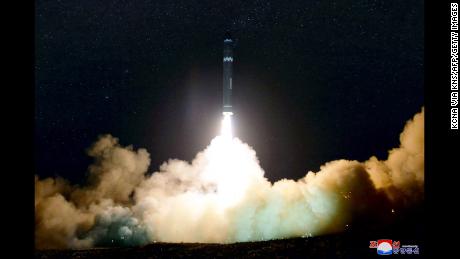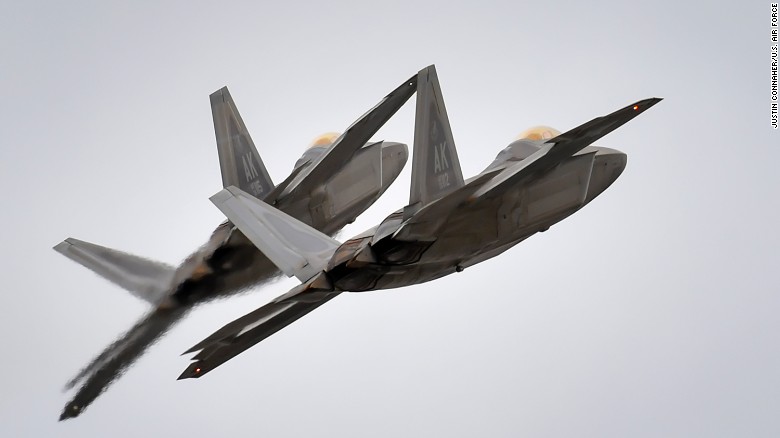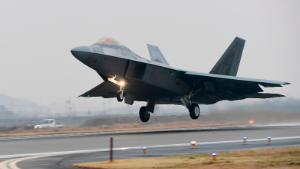US masses stealth jets in South Korea for war games
(CNN)US F-22 fighter jets roared into the sky over South Korea on Monday to start air combat exercises that North Korea says are pushing the peninsula to the brink of nuclear war.
A US 7th Air Force official said the top-of-the-line F-22s are being joined by Air Force and Marine Corps F-35s in the largest concentration of fifth-generation fighter jets ever in South Korea.
The stealthy F-22s and F35s are among 230 US and South Korean aircraft participating in the annual Vigilant Ace 18 air combat drills.
The drills begin after a weekend that saw official sources from both North Korea and the US say the chances of war are growing.
North Korea's bellicose rhetoric came in two phases: On Saturday, a statement from its Foreign Ministry said US President Donald Trump is "begging for a nuclear war" through what it called an "extremely dangerous nuclear gamble on the Korean Peninsula."
A day later, a commentary from Pyongyang's Rodong Sinmun newspaper, carried by the official Korean Central News Agency, said US-South Korea joint air exercises scheduled for Monday to Friday are a "dangerous provocation" pushing the region "to the brink of a nuclear war."
From the US side, White House national security adviser HR McMaster told a conference in California on Saturday that the chances for war on the Korean Peninsula grow daily.
"I think it's increasing every day, which means that we are in a race, really, we are in a race to be able to solve this problem," McMaster told an audience at the Reagan National Defense Forum in Simi Valley.
McMaster made the comment when asked if North Korea's launch of an intercontinental ballistic missile in the early hours of Wednesday morning local time had increased the chance of war.

Watch North Korea's huge new missile launch 00:51
"There are ways to address this problem short of armed conflict, but it is a race because he's getting closer and closer, and there's not much time left," McMaster said, referring to North Korean leader Kim Jong Un.
With every missile launch or nuclear test, Kim has improved his country's capabilities, McMaster said.
US Sen. Lindsey Graham, a Republican hawk who sits on the Senate Armed Services Committee, told CBS News that North Korea's advancing military technology makes the possibility of pre-emptive war more likely.
"I think we're really running out of time," he said.
Graham also said he will urge the Pentagon not to send any military dependents to South Korea.
"It's crazy to send spouses and children to South Korea, given the provocation of North Korea. So I want them to stop sending dependents. And I think it's now time to start moving American dependents out of South Korea," he said.
Air combat exercise begins
Meanwhile, six US Air Force F-22 Raptors, Washington's top-of-the-line stealth fighters, arrived in South Korea on Saturday to participate in the Vigilant Ace 18 air combat exercise, an annual US-South Korea drill the US Air Force says is designed to boost the "combat effectiveness" of the alliance.
Along with the 230 aircraft, 12,000 personnel from the US and South Korea are participating in the weeklong exercise, according to a US Air Force statement.
Photos: In the U.S. Air Force fleet
A-29 Super Tucano – An A-29 Super Tucano taxis on the flightline during its first arrival, Sept. 26, 2014, at Moody Air Force Base, Georgia. Afghan Air Force pilots trained on the planes that will be used in air-to-ground attack missions in Afghanistan.
Hide Caption
13 of 24
Photos: In the U.S. Air Force fleet
KC-135 Stratotanker – The four-engine KC-135 joined the Air Force fleet in 1956 as both a tanker and cargo jet. It can carry up to 200,000 pounds of fuel and 83,000 pounds of cargo and passengers in a deck above the refueling system. More than 400 of the KC-135s are flown by active, Air Guard and Reserve units.
Hide Caption
14 of 24
Photos: In the U.S. Air Force fleet
F-16 Fighting Falcon – The single-engine jet is a mainstay of the Air Force combat fleet. It can perform both air-to-air and air-to-ground missions with its 20mm cannon and ability to carry missiles and bombs on external pods. More than 1,000 F-16s are in the Air Force inventory.
Hide Caption
15 of 24
Photos: In the U.S. Air Force fleet
AC-130 gunships – The AC-130H Spectre and the AC-130U Spooky gunships are designed for close air support, air interdiction and force protection. Armaments on the Spectre include 40mm and 105mm cannons. The Spooky adds a 25mm Gatling gun.
Hide Caption
16 of 24
Photos: In the U.S. Air Force fleet
C-17 Globemaster transport – The four-engine jet joined the Air Force fleet in 1993 with a primary mission of troop and cargo transport. Each plane can carry up to 102 troops or 170,900 pounds of cargo. The Air Force has 187 C-17s on active duty, 12 in the Air National Guard and 14 in the Reserve.
Hide Caption
17 of 24
Photos: In the U.S. Air Force fleet
C-5 Galaxy transport – The C-5, with a wingspan of 222 feet, a length of 247 feet and a height of 65 feet, is the largest plane in the Air Force inventory and one of the largest aircraft in the world. The first versions of the four-engine jet joined the force in 1970. The Air Force expects to have 52 versions of the latest model, the C-5M, in the fleet by 2017.
Hide Caption
18 of 24
Photos: In the U.S. Air Force fleet
CV-22 Osprey – The Osprey is a tiltrotor aircraft that combines vertical takeoff, hover and landing qualities of a helicopter with the normal flight characteristics of a turboprop aircraft, according to the Air Force. It is used to move troops in and out of operations as well as resupply units in the field. The Air Force has 33 Ospreys in inventory.
Hide Caption
19 of 24
Photos: In the U.S. Air Force fleet
E-3 Sentry AWACS – AWACS stands for airborne warning and control system. This four-engine jet, based on a Boeing 707 platform, monitors and manages battle space with its huge rotating radar dome. The planes have a flight crew of four supporting 13 to 19 specialists and controllers giving direction to units around the battle space. The Air Force has 32 E-3s in inventory.
Hide Caption
20 of 24
Photos: In the U.S. Air Force fleet
KC-10 Extender – Based on the DC-10 passenger jet, the triple-engine KC-10 is a gas station in the sky with the ability to carry 75 people and 170,000 pounds of cargo. In its six tanks, the KC-10 can carry up to 356,000 pounds of fuel and dispense it while airborne. The Air Force has 59 KC-10s on active duty.
Hide Caption
21 of 24
Photos: In the U.S. Air Force fleet
T-38 Talon – The twin-engine jet trainer, used by the Air Force to prepare pilots for the F-15E Strike Eagle, F-15C Eagle, F-16 Fighting Falcon, B-1B Lancer, A-10 Thunderbolt and F-22 Raptor, first flew in 1959. Almost 550 are in the active force.
Hide Caption
22 of 24
Photos: In the U.S. Air Force fleet
U-2 – The single-engine, single-pilot U-2 is used for high-altitude reconnaissance and surveillance. Flying at altitudes around 70,000 feet, pilots must wear pressure suits like those worn by astronauts. The first U-2 was flown in 1955. The planes were used on missions over the Soviet Union during the Cold War, flying too high to be reached by any adversary. The Air Force has 33 U-2s in its active inventory.
Hide Caption
23 of 24
Photos: In the U.S. Air Force fleet
WC-135 Constant Phoenix – The four-engine WC-135 is used to fly through airspace to detect the residue of nuclear blasts. "The aircraft is equipped with external flow-through devices to collect particulates on filter paper and a compressor system for whole air samples collected in holding spheres," the Air Force says. It has two of these jets in the active force.
Hide Caption
24 of 24

Photos: In the U.S. Air Force fleet
F-22 Raptor – The twin-engine F-22 stealth fighter, flown by a single pilot and armed with a 20mm cannon, heat-seeking missiles, radar-guided missiles and radar-guided bombs, can perform both air-to-air and air-to-ground missions. The service has 183 of the Raptors, which went operational in 2005.











